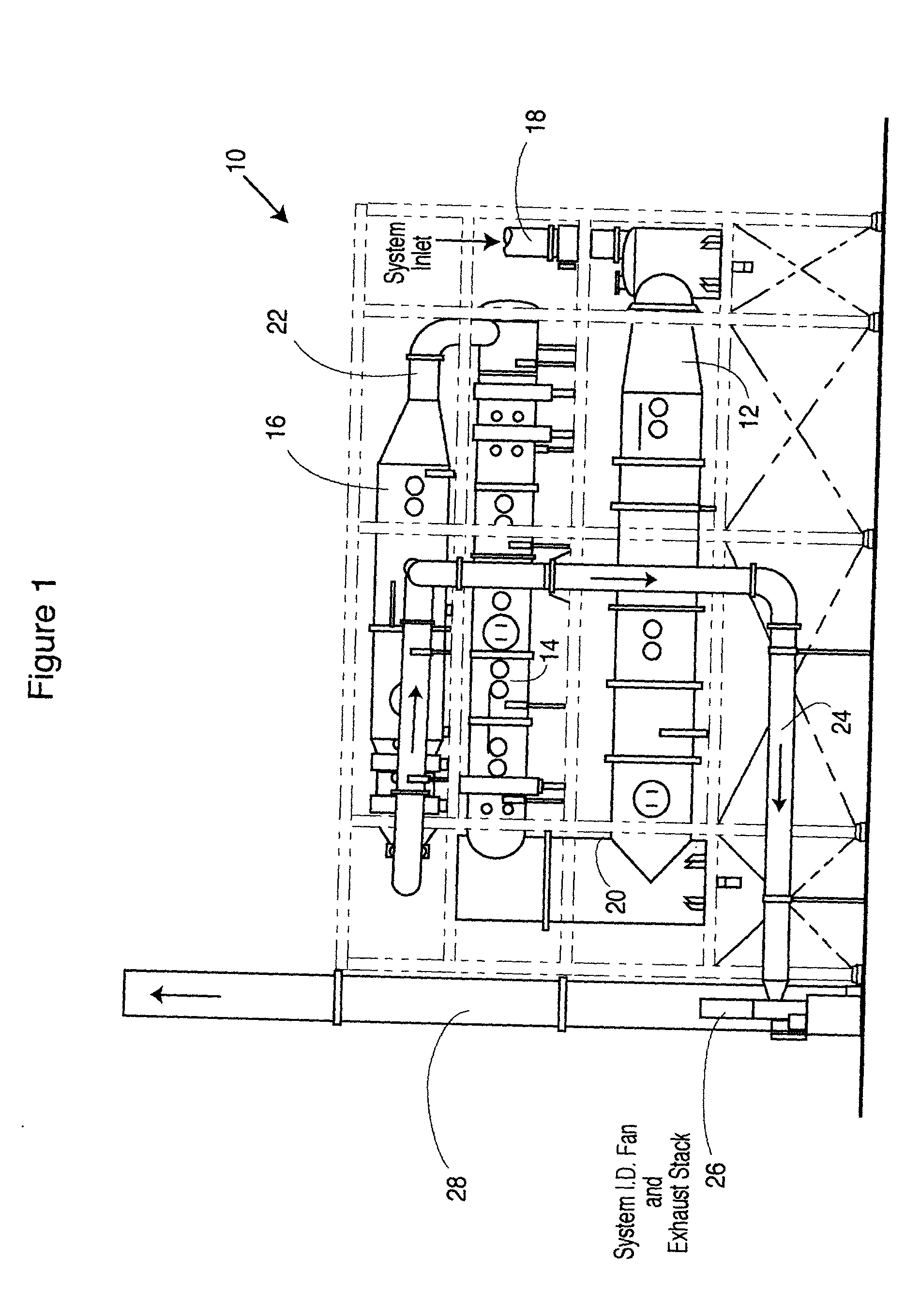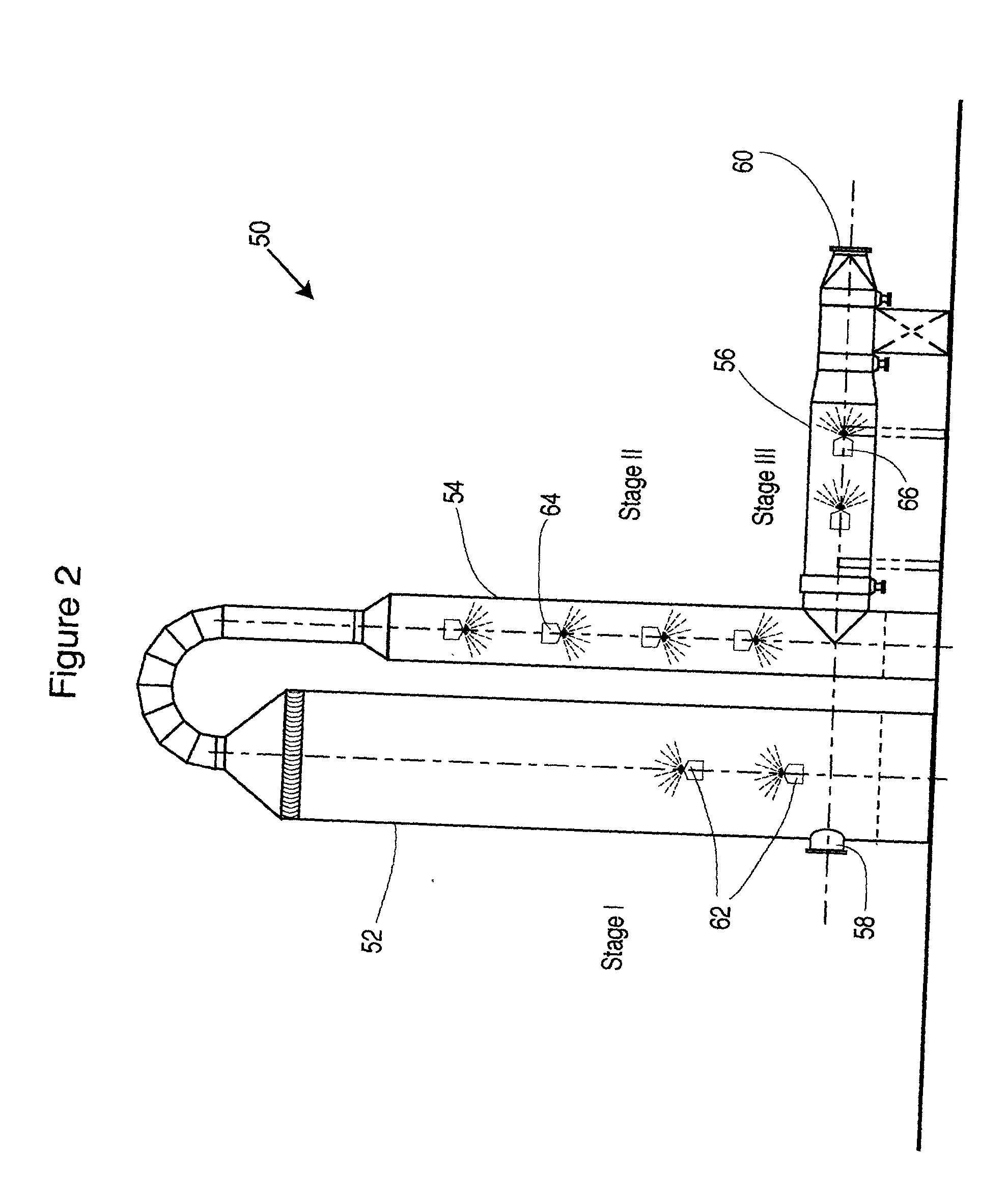Treatment of gas streams containing reduced sulfur compounds
- Summary
- Abstract
- Description
- Claims
- Application Information
AI Technical Summary
Benefits of technology
Problems solved by technology
Method used
Image
Examples
example 1
[0050] A tree-stage scrubber was employed in the form shown in FIG. 1. The NCG-containing gases from a pulp mill entering the scrubbing apparatus were first quenched in a pre-scrubber (first stage) to remove any particulates present, to reduce inlet levels of TRS, and to by the gas to its adiabatic dewpoint. The saturated gas stream then was fed into a reaction / scrubbing stage (second stage) where the gas was intimately contacted in the first stage oxidizer scrubber with a solution containing aqueous chlorine dioxide (ClO.sub.2), which effectively oxidized the reduced sulfur compounds present in the gas stream. The reactions took place in both the liquid and gas phases. The gas steam was then passed through an entrainment separator to remove any ClO.sub.2 liquor and scrubbing product before Me gas stream entered he third stage neutralizer scrubber. The third stage comprised a neutralizing stage where white liquor (or other alkaline / reducing agents) was used to neutralize any acidic ...
example 2
[0051] This Example illustrates the superiority of chlorine dioxide as an oxidant when compared to aqueous sodium hypochlorite.
[0052] A series of experiments were carried out using the equipment illustrated in FIG. 1 on an inlet gas stream containing hydrogen sulfide, methyl mercaptan dimethyl sulfide and dimethyl disulfide, using aqueous sodium hypochlorite ("bhypo"), an aqueous solution of sodium hypochlorite and hydrogen peroxide ("hypo / peroxide") and an aqueous solution of chlorine dioxide as the oxidizing medium.
[0053] The results obtained for typical runs are shown in the following Table:
1 Trial Inlet Outlet Efficiency No. Oxidizer Used H2S MeSH DMS DMDS H2S MeSH DMS DMDS H2S MeSH DMS DMDS 1 hypo 3.749 46.325 46.667 42.509 0.374 4.759 11.796 22.612 90.0 89.7 74.7 46.8 3 hypo @ increased energy 3.749 46.325 46.667 42.509 0.36 0.5 0.55 1.593 90.4 98.9 98.8 96.3 4 hypo @ increased energy 43.155 183.96 81.27 83.475 0.45 0.6 0.77 8.89 99.0 99.7 99.1 91.7 5 hypolperoxide 30.72 141.1...
PUM
| Property | Measurement | Unit |
|---|---|---|
| Size distribution | aaaaa | aaaaa |
| Size distribution | aaaaa | aaaaa |
| Size distribution | aaaaa | aaaaa |
Abstract
Description
Claims
Application Information
 Login to View More
Login to View More - R&D
- Intellectual Property
- Life Sciences
- Materials
- Tech Scout
- Unparalleled Data Quality
- Higher Quality Content
- 60% Fewer Hallucinations
Browse by: Latest US Patents, China's latest patents, Technical Efficacy Thesaurus, Application Domain, Technology Topic, Popular Technical Reports.
© 2025 PatSnap. All rights reserved.Legal|Privacy policy|Modern Slavery Act Transparency Statement|Sitemap|About US| Contact US: help@patsnap.com


